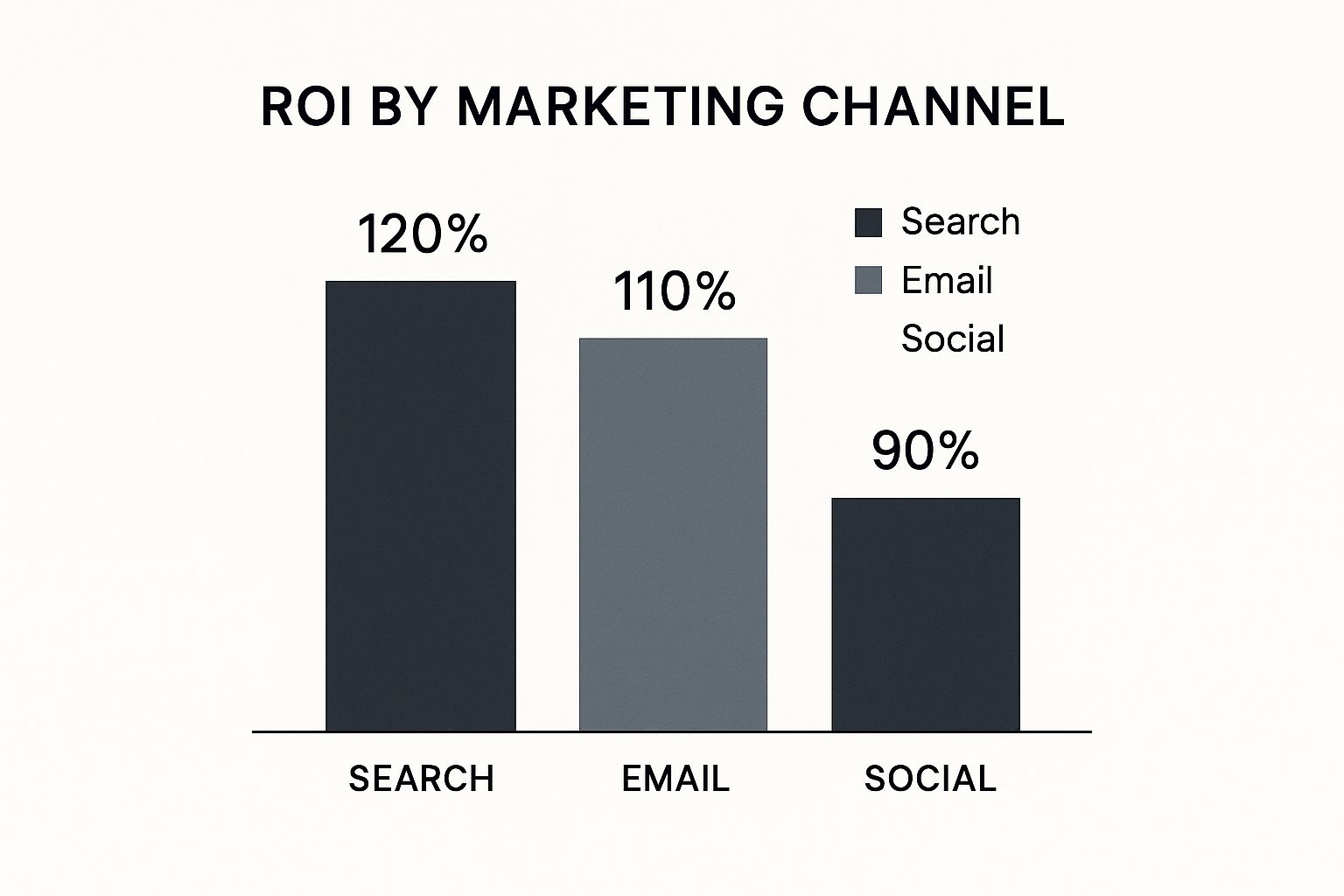Boost Your Marketing Channel Performance Today
Boost Your Marketing Channel Performance Today
Decoding Marketing Channel Performance: Beyond Vanity Metrics

The infographic above shows the return on investment (ROI) from three main marketing channels: Search, Email, and Social. Search comes out on top with an ROI of 120%. Email follows closely behind at 110%, and Social achieves 90%. This highlights how effective search and email marketing can be in generating real business results. Understanding website traffic analysis is also key to decoding marketing channel performance. For more on this, check out this resource: analyze website traffic.
Key Metrics That Matter
It's easy to get caught up in vanity metrics like impressions and reach. However, to truly understand performance, we need to focus on metrics directly linked to business outcomes. Marketing channel performance boils down to conversions and revenue. Here are some key metrics to consider:
- Customer Acquisition Cost (CAC): This tells you how much it costs to get a new customer through each channel.
- Customer Lifetime Value (CLTV): This metric represents the total revenue generated by a customer acquired through a specific channel over their entire relationship with your business.
- Conversion Rate: This measures the percentage of users who complete a desired action, like making a purchase or signing up for a newsletter, after interacting with a channel. For more information on attribution models, see this article: How to master digital marketing attribution models.
Leading vs. Lagging Indicators
Leading indicators offer a glimpse into future performance. Think website traffic and click-through rates. Lagging indicators, such as sales and revenue, confirm past performance. For instance, a high click-through rate on a paid advertising campaign (a leading indicator) suggests a good chance of conversions (a lagging indicator). Understanding this difference is essential for effective marketing channel performance analysis.
Benchmarking for Success
Benchmarking helps put your marketing channel performance into perspective. By comparing your performance to industry averages and competitors, you can identify areas for improvement and growth opportunities. Remember to tailor benchmarks to your specific business model and objectives.
To help understand these key metrics across different channels, take a look at the table below:
Essential Performance Metrics by Marketing Channel
A comprehensive comparison of key performance indicators across different marketing channels to help marketers understand what metrics matter most for each channel
| Marketing Channel | Primary KPIs | Secondary KPIs | Conversion Metrics | ROI Calculation Method |
|---|---|---|---|---|
| Search (SEO/PPC) | Click-through rate (CTR), Conversion rate, Average position | Impressions, Clicks, Cost per click (CPC) | Leads, Sales | (Revenue - Cost) / Cost |
| Open rate, Click-through rate (CTR), Conversion rate | Deliverability rate, Unsubscribe rate, Bounce rate | Leads, Sales | (Revenue - Cost) / Cost | |
| Social Media | Engagement rate, Reach, Impressions | Click-through rate (CTR), Website traffic | Leads, Sales | (Revenue - Cost) / Cost |
This table summarizes the most important metrics for each channel. By tracking these metrics, you can gain a clearer understanding of your overall marketing effectiveness.
Email marketing has historically shown a high ROI. In 2021, email delivered an average ROI of $44 for every dollar spent, proving its strength in driving conversions. This success is due to factors like personalized messaging and direct access to customer data. For more on top marketing channels, see: top marketing channels. The rising importance of privacy regulations and the decline of third-party cookies further strengthens email's position in the marketing mix. Analyzing these key performance indicators helps marketers understand their marketing channel performance and make informed decisions to optimize their strategies.
Content Marketing: The Force Multiplier for Channel Performance

Content marketing isn't just another channel; it's the driving force behind successful marketing across all channels. It's the bedrock of effective paid, owned, and earned media strategies. It's the story that connects with your audience and keeps them engaged throughout their buying process.
Content Fuels the Ecosystem
Strategic content boosts performance by nurturing leads, building trust, and driving conversions. A well-written blog post, for example, can attract organic traffic from search engines like Google. This traffic can then be retargeted with paid ads on social media platforms like Facebook or Instagram. This integrated approach maximizes reach and impact.
Compelling content shared on social media platforms also expands brand awareness and drives traffic back to your website. To gauge the effectiveness of your content, focus on key customer success metrics. You can learn more about these at Statisfy.
Measuring Content's True Impact
Measuring content marketing success involves more than just tracking likes and shares. It’s about understanding how content influences actual business results, like conversions and revenue. This requires practical content attribution frameworks.
By analyzing which content types perform best on different channels, you can fine-tune your strategy. Perhaps case studies are effective at converting email leads, while infographics excel on social media.
Content marketing is now a core component of digital marketing, with significant data backing its effectiveness. The global content marketing industry is expected to reach $94 billion by 2025, with projected growth of 10.4% in 2026. More detailed statistics are available here. This growth underscores the power of content to engage audiences and elevate brand visibility.
Integrating Content Across Your Marketing Mix
Leading brands integrate content across all their marketing efforts for better returns on investment. They recognize that content marketing isn't a separate activity, but rather a crucial piece of a larger, connected strategy.
This involves aligning content with business goals and using it to support every step of the customer journey. This ensures consistent messaging and a smooth brand experience.
Building Trust and Nurturing Leads
Content is key for building audience trust and nurturing leads. By providing valuable, relevant information, you establish yourself as an expert and build credibility. This trust encourages customers to engage with your brand and ultimately convert.
Through informative blog posts, captivating videos, and interactive webinars, you can guide leads through the buying process and towards a purchase.
Cracking the Attribution Code: Models That Actually Work

Understanding marketing channel performance depends on accurate attribution. This means figuring out which marketing efforts lead to conversions, giving credit where it's due. But today’s customer journey isn't always straightforward. Customers often interact with many channels before buying, making attribution tricky.
Navigating the Attribution Maze
Simple models like first-touch (crediting the first interaction) or last-touch (crediting the last interaction) offer a basic view. But they miss the influence of other touchpoints. For example, imagine a customer finds a product through a social media ad (first-touch) and later buys it after clicking a search ad (last-touch). Both channels played a role, but a last-touch model would only credit the search ad.
Advanced Attribution Models: A Deeper Dive
This is where more advanced models are useful. Multi-touch attribution models, like linear, time decay, and position-based models, spread credit across multiple touchpoints. These models offer a more detailed view of marketing channel performance by recognizing the influence of each interaction.
- Linear Attribution: Credit is distributed evenly across all touchpoints involved.
- Time Decay Attribution: Touchpoints closer to the conversion get more credit.
- Position-Based Attribution: The first and last touchpoints receive the most credit, with less credit going to the touchpoints in between.
To help visualize the differences, let's take a look at the following comparison:
Comparison of Attribution Models for Marketing Channel Analysis
Analysis of different attribution models with their advantages, disadvantages, and optimal use cases to help marketers choose the right approach for their business
| Attribution Model | How It Works | Best For | Limitations | Implementation Complexity |
|---|---|---|---|---|
| First-Touch | 100% credit to the first touchpoint | Simple tracking, identifying initial sources | Ignores other influencing touchpoints | Low |
| Last-Touch | 100% credit to the last touchpoint | Easy to implement, focusing on closing channels | Overlooks earlier stages in the customer journey | Low |
| Linear | Evenly distributes credit across all touchpoints | Understanding all touchpoints' contributions | May not reflect the actual weight of each touchpoint | Medium |
| Time Decay | More credit to touchpoints closer to conversion | Highlighting marketing efforts that accelerate conversions | Can undervalue early-stage engagement | Medium |
| Position-Based | Most credit to first and last touchpoints | Emphasizing initial awareness and final conversion drivers | May undervalue mid-funnel engagement | Medium |
As you can see, each model has its own strengths and weaknesses. Choosing the right one depends on your specific business goals.
Algorithmic Attribution: Working With Data
Beyond these rule-based models, algorithmic attribution uses statistical modeling and machine learning. These models analyze large datasets to determine each touchpoint's actual contribution. They offer a more advanced approach to understanding marketing channel performance but require significant data and technical expertise. Learn more about different attribution models in this article: attribution model examples.
Choosing the Right Attribution Model
The best attribution model depends on your specific goals and available resources. A simple first-touch or last-touch model might be enough if you're just starting out. As your data and analytical capabilities grow, you can explore more complex models.
Beyond Attribution Models: A Holistic Perspective
Choosing the right attribution model is important, but it's equally important to ensure everyone is on the same page. Marketing and sales teams need to agree on the chosen model and how it affects marketing channel performance evaluation. This shared understanding ensures that everyone works towards the same goals and resources are used effectively. Smart marketers know that attribution isn't just about assigning credit; it's about gaining useful insights to optimize campaigns and improve overall performance. You might find this helpful: How to master attribution model examples. This involves looking beyond individual channel metrics and embracing a unified view of the customer journey.
Optimizing Your Channel Mix: Strategic Allocation for Maximum Impact
Optimizing individual marketing channels is essential. But coordinating your entire marketing ecosystem is where the real power lies. This means understanding each channel's contribution to your goals and allocating your budget effectively. Think of your marketing channel mix like an orchestra. Each instrument (channel) plays a unique role. Beautiful music (results) only happens when they work together in harmony.
Actionable Frameworks for Budget Allocation
Developing a strong budget allocation strategy involves analyzing several key factors. These include your performance data, business objectives, and audience behavior. This goes beyond simply investing in channels that appear to be working. A data-driven approach is essential.
For example, suppose your data shows email marketing consistently delivers high conversion rates for a specific product. It makes sense to allocate more of your budget to email campaigns promoting that product. On the other hand, if social media is generating brand awareness but few conversions, you might shift some budget to a channel better at driving sales.
- Data Analysis: Analyze historical data to see which channels have the best ROI.
- Business Objectives: Align your channel mix with your specific goals, like lead generation, brand awareness, or sales.
- Audience Behavior: Understand where your target audience spends time online and focus your efforts there.
Continuous Testing and Experimentation
Setting a baseline channel mix is just the beginning. Marketing channel performance is constantly changing. What works today might not work tomorrow. That's why continuous testing and experimentation are so important. This involves setting up control groups to accurately measure the impact of different campaigns.
You could test different ad copy on Facebook to see which resonates best. Or experiment with email subject lines to improve open rates. By constantly testing and iterating, you can improve your marketing channel performance.
Balancing Short-Term Gains and Long-Term Growth
Successful organizations balance immediate results with long-term brand building. While it's tempting to focus solely on quick wins, neglecting brand building can be detrimental.
Think of it like investing. You need a mix of short-term and long-term investments to achieve your financial goals. Similarly, a balanced marketing channel mix is crucial for both immediate and sustainable growth. This might mean allocating budget to brand awareness channels like social media, even if they don't directly drive short-term sales.
Adapting to Change: Reallocating Resources
Many factors can impact your marketing channel performance. These include market dynamics, seasonal changes, and competitive pressures. Be flexible and willing to reallocate resources as needed.
For instance, during peak season, you might increase paid advertising spending to capitalize on demand. Or, if a competitor launches a new product, you might focus on content marketing to highlight your product's advantages.
By monitoring your marketing channel performance and adapting your strategy, you can stay ahead and maximize your impact. Learn more about optimizing your marketing channels on LeadPulse.com. This proactive approach ensures you're always getting the most out of your marketing investment, regardless of market challenges. Remember, a successful marketing strategy is dynamic, requiring continuous optimization and adaptation.
Connected Data, Powerful Insights: Integration Strategies That Scale

Understanding marketing channel performance depends on breaking down data silos. This means connecting different data sources to see the complete customer journey. This section explores practical data integration methods for better decisions, even without large technology budgets.
Combining Customer Data and Channel Metrics
Combining customer data with channel metrics gives businesses a deeper understanding of audience behavior. Imagine an e-commerce store. Integrating your CRM data with your email marketing platform shows which customer segments respond best to specific promotions. This enables more targeted campaigns, improving marketing channel performance. This insight helps identify preferences across different touchpoints for a more personalized customer experience.
Leveraging Accessible Tools
Many organizations use tools like customer data platforms (CDPs), marketing automation software, and business intelligence (BI) tools to unify their marketing performance data. These tools create a central hub for marketing data, simplifying analysis and reporting on marketing channel performance.
- CDPs: Collect and organize customer data from various sources, creating a single customer view.
- Marketing Automation: Automates repetitive tasks and provides campaign performance data.
- BI Tools: Offer powerful data visualization and analysis, uncovering hidden insights.
Implementing Consistent Tracking
Consistent tracking is key for accurate marketing channel performance measurement. This means using the same tracking parameters across all channels. Consistent UTM parameters in URLs, for instance, effectively track traffic sources. This creates a clear picture of each channel's contribution to overall marketing goals. For more on enhancing tracking and analysis, see our guide on the best marketing attribution tools for 2025.
Addressing Data Quality Challenges
Data quality is critical. Inaccurate or incomplete data leads to flawed analysis and poor decisions. Regular data audits and cleaning maintain data integrity, ensuring reliable marketing channel performance reports. This includes error correction and filling in missing data.
Balancing Depth and Actionable Insights
In-depth analysis is important, but focus on actionable insights. Data overload can be overwhelming. Identify key metrics impacting business objectives and prioritize them. This focused approach translates data into meaningful actions that improve marketing channel performance. Finding the right balance enables informed decisions that drive results.
Future-Proofing Your Performance Measurement Framework
Marketing channel performance measurement is constantly changing. Platform updates, algorithm tweaks, and evolving privacy regulations are just some of the challenges marketers face. Building a resilient measurement framework is now more critical than ever. Let's explore some strategies to maintain effective tracking and optimization in this ever-shifting landscape.
First-Party Data: Taking Control of Your Insights
First-party data is information collected directly from your audience through your website, CRM software, email marketing, and other owned channels. Its importance is growing as third-party cookies decline.
- Directly from the source: You own and control this data, which makes it more reliable and less vulnerable to external changes.
- Building trust: Transparent data collection builds trust and strengthens relationships with your audience.
- Deeper insights: First-party data offers detailed insights into customer behavior and preferences, enabling more effective personalization.
For example, in an online store, data from customer purchases and website interactions provides a clearer view of product preferences and buying habits. This allows for more targeted promotions and product recommendations, boosting marketing channel performance.
Navigating the Privacy Landscape
Privacy regulations, such as GDPR and CCPA, are changing how businesses collect and use data. Implementing robust consent management protocols is crucial for compliance. This includes providing users with clear choices about data collection and usage, along with accessible opt-out options.
Adopting privacy-compliant tracking methods, like differential privacy and federated learning of cohorts (FLoC), enables data analysis while protecting user privacy. These methods add noise to individual data points while preserving aggregate insights.
Adapting to Platform Changes and API Limitations
Platforms frequently update their algorithms and APIs, impacting data access and reporting. Staying aware of these changes is essential for adapting your measurement framework.
- Regular Audits: Conduct regular audits of your tracking and reporting to catch any issues stemming from platform updates.
- Diversification: Avoid relying on a single platform. Diversify your data sources to reduce the risk of platform-specific disruptions.
- Flexibility: Be ready to adjust your strategies based on platform changes. This might involve exploring alternative tracking methods or adopting different reporting tools.
For example, if a social media platform restricts access to certain metrics, explore other available data points or shift your focus to other channels.
Balancing Granular Measurement With Ethical Data Practices
While granular data provides valuable insights, it's essential to balance the need for detailed measurement with ethical data practices. This means being transparent about data collection, respecting user privacy, and using data responsibly.
By prioritizing both effective measurement and responsible data handling, you can create a future-proof performance measurement framework that delivers valuable insights while maintaining ethical standards. This approach builds trust with your audience and ensures long-term sustainability.
Want to understand your marketing channel performance better and gain deeper insights into your lead and customer sources? LeadPulse can help. LeadPulse offers the tools and insights you need to connect your marketing efforts to tangible results. See where your leads and customers originate, beyond just paid campaigns and UTM parameters. Learn more about how LeadPulse can help optimize your marketing channel performance.